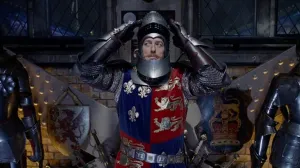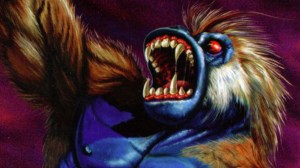Videos by ComicBook.com
It’s his first long-form project as both writer and artist, after notable work in both categories in recent years, and it’s a fantasy story that he jokes is Spider-Man in a Dickensian world, but with a young adult feel and a fantasy twist.
Corona joined ComicBook.com to talk about the series.
I know your work from Goners, where you didn’t pull double duty. Is this the biggest project you’ve ever both written and drawn?
This is definitely been the biggest project I’ve pulled double duty on. I have written and drawn short stories for anthologies in the past and I’ve worked as illustrator for Goners, like you said, and for Teen Titans GO! For DC Comics, but to handle both aspects for this long, Feathers is the first.
It’s been a learning process and I’m lucky to learn from the people I’m working with on the other books and hopefully I’m bringing a little bit on that on Feathers.
There’s certainly a feeling that Archaia is a great place to be for this kind of book. What drew you to them?
It was a matter of all things kind of clicking at the right time. I met Rebecca Taylor, the editor, on my first year at SCAD while I was getting an MFA in Sequential Arts and we hit it off. We stayed in touch for about a year or so, running into each other at conventions and by email, and to be honest I really wanted to work with her. I knew that for Archaia I had to go in with a pitch and by that time I was mostly working on building a portfolio of sample pages. I always loved the kind (And the quality!) of books Archaia published and had the idea for Feathers circling in my head for a few years by then, figured it was a perfect fit. Rebecca was schedule to visit the school on my last quarter there so I prepared a pitch with the synopsis and the first five pages of the story, called Poe at that time, and showed it to her. Thankfully she liked it, we went ahead and submitted it through the proper channels and not much later than that we were working on the book.
Is there any particular myth that Poe is based on?
Poe started as a Beauty and the Beast-type of character, back when I first started playing with the idea. A lot of his core came from that moment, with time his story kept expanding in my head and more and more I was taking from different sources. The whole book is a mix of themes and genres that have, in one way or another, interested me as I grew up and nowadays. It is, in a way, a tribute to those stories I read as a kid, something I would have loved to read at that time.
What’s the in-story reason for everybody calling the street kids “mice?”
I think somewhere around issue two or three I touch on the name, but basically they are the inhabitants of the alleys and streets of the Maze, the run around taking food and things they need from anyone who isn’t paying attention, they are not seen with kind eyes by everyone else so they are treated like pest, that’s mostly where the name comes from. They have learned to wear it proudly because it is the way they have managed to survive in that world.
If you want to know why they are named by a single letter, is because they don’t know how to read or write so if they ever need to spell their names they just have to learn one letter.
This feels tonally a lot different than Goners, and not just because it’s a kids’ story. Your art is quite different. Were you drawing inspiration from anyplace in particular for this book?
For a long time, before getting to work in comics, I worked as a Graphic Designer and Illustrator for magazines and advertising. This left me with an automatic response to always think differently for each client/project. I like, to some extent, to do the same with the books I work on. Like you say, Goners is very different from Feathers tonally and I wanted to show that in the way the art was done for each project too. I like to do my research and look for references before working on a book and these were also lead me in separate directions for one book or the other. I think for this book I tried to look a lot into European comics and artists for inspiration, I wanted it to feel closer to a classic fairy tale in that sense.
There was a lot to establish in the first issue. How did you get it all in without the pacing feeling cramped?
Ha! This actually makes me really happy. Building this world from the ground up was a bit of a challenge because you never want to just come out and explain everything to the reader; you want things to come clear more organically. One of my biggest concerns was that I wanted to get the basics rules in this first issue and constantly felt like I was maybe cutting it too short. So it feels good to hear that it doesn’t come along as cramped, thanks.
I do think some things will become clearer as the next few issues come along, and others will take the whole arc to be answered, but that’s part of the fun of the story. The main thing in issue #1 was to know the main characters and at least show the supporting cast while advancing in the world building. I’m a big fan of making connections so a lot of it was to adapt these first few moments to characters and places that will take more relevance as we move forward.
How do you plan to explore the push-and-pull between Bianca and Pop, since really Poe only has the two so far, and they seem to have almost diametrically opposing views on the world?
Gabriel’s point of view will constantly be showing through Poe’s actions and way of thinking. He’s been raised by Gabriel so even though he’s a bit rebellious he has learned to view the world through his father’s eyes. Bianca will constantly be pushing Poe out of his comfort zone, and consequently playing off Gabriel’s upbringing. There will be a moment of more direct confrontation and Poe will have to choose and make his own mind but the whole story takes the length of two days, and we know Gabriel and Poe interact at night, so for the most part this conflict between Bianca and Gabriel will be an indirect one.
The book is actually pretty cheerful, considering how bleak the premise is. How do you balance that?
Feathers is a romanticized view of a very tragic world; there are orphans, child-snatchers, poverty, and strongly defined social discrimination; in a way, making it cheerful was the only way of not making it totally depressing. I wanted to keep this book all-age friendly, mostly because the core of the story is that there’s magic hidden even in a place like this, and I think that’s a very important message for young readers to get. For the older audience there will be different layers that will become more obvious for them and, hopefully, invite them to keep coming for more.
As for the plot itself, things will get darker as the characters immerse themselves in this world and, by keeping it lighter in tone early on, those dark moments will have a bigger impact once they hit.
Can you tell us in a sentence or a few what you’d tell a reader to convince them to try out the series?
Ha! I would get really close to them and whisper: “If you think about it, Feathers is like Spider-Man in a Dickensian world.” And then I would throw the book at them and run away.









